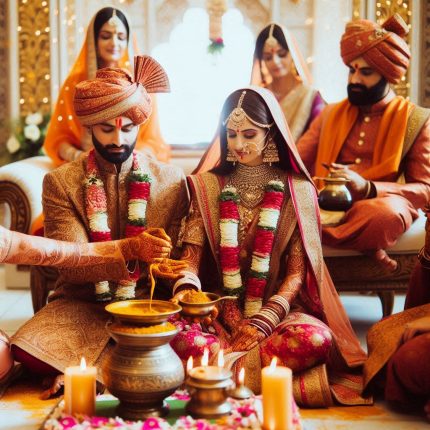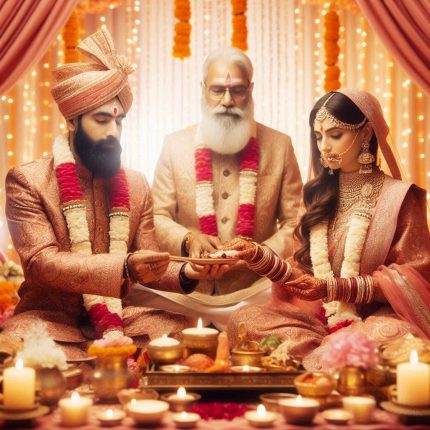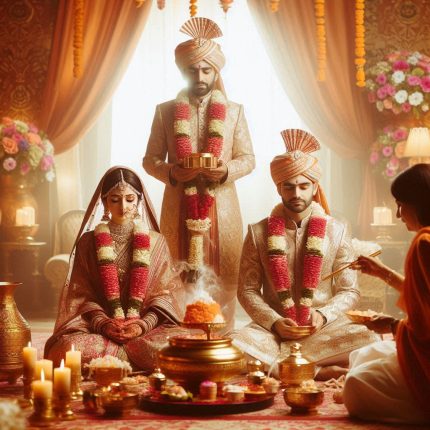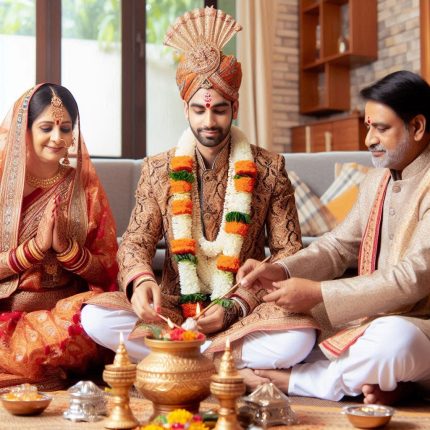Roka Ceremony Puja: The Formalization of Commitment
Samagri
for Puja:
Haldi [organic] (20gm), Kumkum [organic] (20gm), Tulsi Mala (1), Diya Batti (5), Beetle Nuts (5), Desi Ghee (20ml), Honey (20ml), Jaggery (Gudh) (20gm), Akshata [Yellow rice] (20gm), Yagno-paveetha (5), Karpoora [camphor] (5Tabs), Red/White/Yellow Cloth(1 mtr), Prasad [Laung, Elaichi, Mishri] (20gm), Mouli (25mtr), Ganga Jal (15ml), Durva [fresh] (1), Agarbatti (6)/Dhoop (2), Dakshina (100INR), God Idols (pair), Sambrani (2), Sambrani Holder (1), Kalash [small copper] (1), Panchpatra [small copper] (1), Diya Holder (2), Panchamrit spoon (1), Karpoora Holder(1), includes perishables [Beetle Leaves [fresh] (9), Flowers [fresh] (incl mala), Tulsi [fresh], Mango Leaves [fresh] (7)]
Small Havan:
Cow Dung Cake (2), Mango Wood (250gm), HavanSamagri [20+ Grganic Herbs] (100gm), Ghee (20ml)
Yajman to provide:
Curd (100gm), Milk (100ml), Mithai (250gm), Fruits [5types], Coconut (1), HavanKund, SuchiSarva (Havan Spoon) (1), Kalash [big] (1), Bowl [preferably copper/silver] (1), Spoon [preferably copper/silver] (1), Utensils [2 big Plates (for Aarti/Samagri), disposable Plates, Bowls & Spoons], First solid food (preferably Kheer or Payasam)
Introduction
The Roka Ceremony, also known as the Roka Puja, is a significant ritual in many cultures, marking the formal initiation of the marriage process. It is a heartfelt and traditional event where both families come together to acknowledge and celebrate the commitment between the bride and groom. This ceremony often precedes the engagement and is an important step in solidifying the relationship, ensuring that both families agree and bless the union.
Importance and Significance of Roka Ceremony Puja
The Roka Ceremony holds deep cultural and spiritual significance:
- Formal Commitment: The Roka Ceremony is the official declaration of the couple’s intention to marry. It marks the transition from dating or courtship to a committed relationship, acknowledging the seriousness of their union.
- Family Approval: This ceremony symbolizes the formal acceptance and approval of the marriage by both families, reinforcing the bond between them.
- Blessings and Prosperity: The puja is conducted to seek divine blessings for the couple’s future, ensuring that their journey together is filled with joy, harmony, and prosperity.
- Cultural Tradition: The Roka Ceremony upholds cultural values and traditions, strengthening familial ties and preserving heritage.
Benefits of Roka Ceremony Puja
Participating in the Roka Ceremony offers several benefits:
- Official Recognition: It formally recognizes the relationship, providing a sense of security and validation for the couple.
- Family Bonding: The ceremony fosters unity and mutual respect between the two families, setting a positive tone for the upcoming wedding.
- Divine Blessings: The puja invokes blessings from deities for the couple’s happiness and a harmonious marital life.
- Cultural Connection: Engaging in traditional practices enriches the cultural experience and strengthens family traditions.
Occasions to Perform Roka Ceremony Puja
The Roka Ceremony is typically held before the engagement and is a precursor to the wedding celebrations:
- Pre-Engagement Ritual: It is usually performed after the families have agreed on the marriage proposal but before the formal engagement ceremony.
- Timing: The exact timing can vary based on cultural practices and family preferences. It is often conducted at a mutually convenient time for both families.
Roka Ceremony Puja Vidhi (Procedure)
The Roka Ceremony involves several traditional steps, each adding to the ritual’s significance:
- Preparation: Both families prepare for the ceremony by dressing in traditional attire. The ceremony is often held at the bride’s or groom’s home, decorated with flowers and traditional elements.
- Welcome and Introduction: The groom’s family formally visits the bride’s family, and both families exchange warm greetings and gifts as a sign of goodwill.
- Formal Declaration: The families officially acknowledge the commitment between the bride and groom. This may involve a formal statement or declaration of the couple’s intention to marry.
- Puja Rituals: A priest may perform a brief puja to seek divine blessings for the couple’s future. This typically includes offering prayers, performing aarti, and making symbolic offerings.
- Exchange of Gifts: Both families exchange gifts as a symbol of goodwill and acceptance. These gifts often include traditional items, sweets, and tokens of appreciation.
- Blessings: The couple seeks blessings from their elders and family members. This may involve touching the feet of elders and receiving their good wishes.
- Celebration: The ceremony is often followed by a small celebration, including a meal and socializing, allowing both families to bond and rejoice in the occasion.
Roka Ceremony Shubh Muhurat
The Shubh Muhurat (auspicious time) for the Roka Ceremony is often chosen based on astrological considerations, ensuring that the event aligns with favourable planetary positions. Consulting with an astrologer can help determine the best time for the ceremony, enhancing its positive effects.
Conclusion
The Roka Ceremony is a cherished tradition that formalizes the commitment between the bride and groom, bringing together their families in celebration and approval. It is a significant step in the wedding journey, marking the beginning of a lifelong partnership. By participating in this sacred ritual, families honour their cultural heritage and seek divine blessings for a joyful and harmonious future for the couple.






